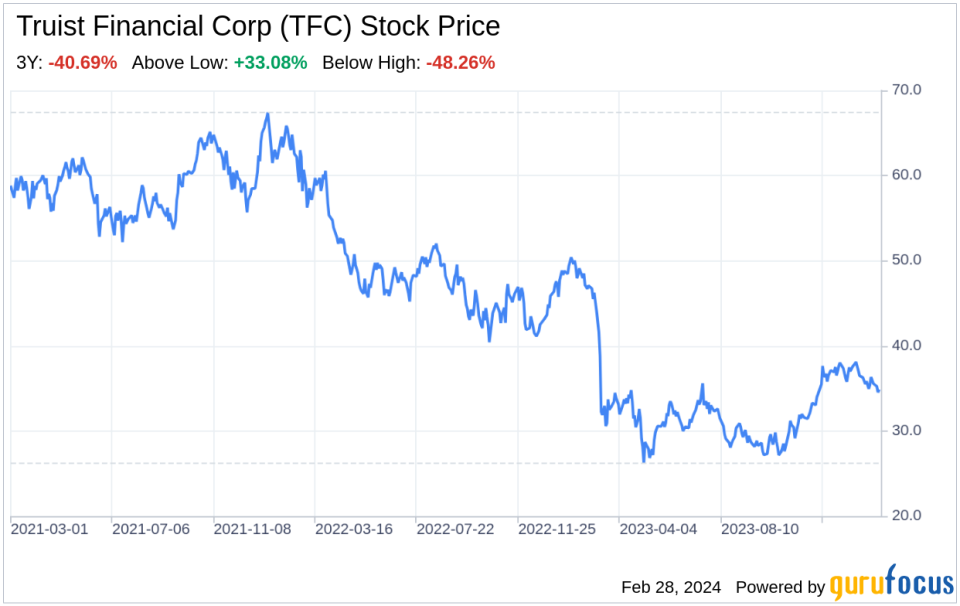Decoding Truist Financial Corp (TFC): A Strategic SWOT Insight
Truist Financial Corp demonstrates robust capital levels with a CET1 ratio of 10.1% as of December 31, 2023.
The company faces intense competition from fintechs and non-bank platforms, potentially impacting market share.
Opportunities for growth through strategic mergers and acquisitions align with Truist's forward-looking strategies.
Operational risks and the need for continuous technological innovation pose significant threats to Truist's business model.
Truist Financial Corp (NYSE:TFC), headquartered in Charlotte, North Carolina, is a leading commercial bank that emerged from the merger of BB&T and SunTrust. With a strong presence in the Southeastern United States, Truist operates through a network of 2,001 offices as of December 31, 2023, and offers a comprehensive range of services, including commercial and retail banking, investment banking, insurance, and wealth management. On February 27, 2024, Truist released its annual 10-K filing, providing a detailed financial overview and insights into its operations. The company's capital position remains solid, with a CET1 ratio of 10.1% as of December 31, 2023, reflecting organic capital generation and strategic financial maneuvers. Despite a competitive landscape, Truist continues to focus on client-first strategies and digital innovation to maintain and grow its market share.

Strengths
Market Position and Client-First Approach: Truist Financial Corp boasts a leading market share in several high-growth markets across the United States, a testament to its strong brand and client-first approach. This strategy has been a cornerstone of Truist's success, fostering loyalty among its consumer and small business banking clientele. The company's commitment to meeting the financial needs of its clients has enabled it to diversify its revenue streams and enhance profitability. Moreover, Truist's investments in digital platforms have positioned it competitively in meeting clients' expectations in an increasingly digital world.
Capital Strength and Dividend Payments: Truist's robust capital levels, as evidenced by a CET1 ratio of 10.1%, underscore its financial resilience and ability to withstand economic fluctuations. The company's capital management strategy prioritizes organic growth and shareholder returns, with $2.8 billion paid in common stock dividends in 2023. This capital strength not only provides a buffer against potential losses but also instills confidence among investors and regulators.
Weaknesses
Intense Competition and Technological Disruption: Truist faces fierce competition from traditional financial institutions and non-bank entities, including fintechs and technology companies. These competitors often operate under less stringent regulatory frameworks, allowing them to offer more favorable rates and innovative services. Truist's ability to retain market share and client loyalty hinges on its capacity to adapt and innovate in response to these competitive pressures. The company's future success will depend on its strategic investments in technology and its agility in rolling out new products and services.
Operational Risks and Cybersecurity: As Truist expands its product offerings and delivery platforms, it encounters new operational risks that may not be fully appreciated or controlled. The potential for system failures, data breaches, and other cybersecurity incidents poses a significant threat to the company's operations and reputation. Truist's risk management framework is designed to mitigate these risks, but the rapidly evolving nature of technology and cyber threats means that no system can be entirely foolproof.
Opportunities
Strategic Mergers and Acquisitions: Truist's merger and acquisition strategy focuses on enhancing growth by acquiring businesses that strengthen its market position and capabilities. The company's approach to M&A is disciplined, ensuring that any potential acquisition aligns with its strategic objectives and cultural values. Given Truist's strong capital position, it is well-equipped to pursue such opportunities, which could lead to increased market share, expanded product offerings, and improved client experiences.
Technological Innovation and Digital Banking: The ongoing digital transformation in the banking industry presents significant opportunities for Truist to innovate and capture market share. Investments in mobile and online applications, artificial intelligence, and advanced data analytics can enhance the client experience and operational efficiency. By staying at the forefront of technological advancements, Truist can differentiate itself from competitors and cater to the evolving needs of its clients.
Threats
Regulatory Changes and Compliance Risks: The financial services industry is subject to constant regulatory changes, which can impact Truist's operations and competitive landscape. Compliance with new regulations may require substantial investments and could alter the way Truist conducts business. Additionally, heightened scrutiny from regulatory bodies can lead to increased operational costs and potential penalties for non-compliance.
Economic Uncertainties and Market Volatility: Truist's performance is influenced by economic conditions, interest rate fluctuations, and market volatility. Adverse economic developments can affect client behavior, leading to reduced demand for banking products and services. Furthermore, market volatility can impact the valuation of Truist's investment portfolio and its ability to access capital markets on favorable terms.
In conclusion, Truist Financial Corp (NYSE:TFC) exhibits a strong market position and capital robustness, which are central to its competitive advantage. However, the company must navigate a landscape marked by intense competition, technological disruption, and operational risks. Opportunities for growth through strategic initiatives and technological innovation are promising, yet Truist must remain vigilant against regulatory challenges and economic uncertainties. By leveraging its strengths and addressing its weaknesses, Truist can capitalize on opportunities and mitigate threats, positioning itself for continued success in the dynamic financial services sector.
This article, generated by GuruFocus, is designed to provide general insights and is not tailored financial advice. Our commentary is rooted in historical data and analyst projections, utilizing an impartial methodology, and is not intended to serve as specific investment guidance. It does not formulate a recommendation to purchase or divest any stock and does not consider individual investment objectives or financial circumstances. Our objective is to deliver long-term, fundamental data-driven analysis. Be aware that our analysis might not incorporate the most recent, price-sensitive company announcements or qualitative information. GuruFocus holds no position in the stocks mentioned herein.
This article first appeared on GuruFocus.
